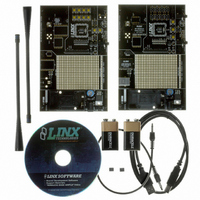MDEV-LICAL-HS Linx Technologies Inc, MDEV-LICAL-HS Datasheet - Page 4

MDEV-LICAL-HS
Manufacturer Part Number
MDEV-LICAL-HS
Description
DEV SYSTEM HS SERIES 418MHZ
Manufacturer
Linx Technologies Inc
Type
Encoder, Decoderr
Datasheet
1.MDEV-LICAL-HS.pdf
(9 pages)
Specifications of MDEV-LICAL-HS
Supply Voltage (min)
7 V
Product
RF Development Tools
Supply Voltage (max)
16 V
Lead Free Status / RoHS Status
Contains lead / RoHS non-compliant
For Use With/related Products
HS Series Encoder and Decoder
Lead Free Status / Rohs Status
Lead free / RoHS Compliant
Other names
MDEV-LIC-HS
MDEV-LIC-HS
MDEV-LIC-HS
THE ENCODER BOARD
Page 6
Figure 4: The Encoder Area
The Encoder Area
The encoder board has three sections that are of primary interest: the encoder
area, the transmitter area, and the key exchange area.
The figure below shows the encoder area of the development board.
The encoder is located in the center beneath the Linx logo. To the right are
buttons that will pull the encoder data lines high when pressed. Button S0
corresponds to data line D0, button S1 to data line D1 and so forth.
The diodes to the left isolate the data lines from each other while allowing any
line to activate the SEND line.
Beneath the encoder are two LEDs. D12 is connected to the MODE_IND line
and will light up as described in the HS Encoder Data Guide. D8 is connected to
the TX_CNTL line and will provide visual feedback by lighting up when the
encoder sends a word.
Beneath the LEDs is a button that is connected to the CREATE line. This button
is used to create a PIN as described in the HS Series Encoder Data Guide.
There are two function switches to the left of
the CREATE button. BSEL0 is used to set the
baud rate of the encoder as described in the
adjacent table. *Important* The decoder
board must be set to the same baud rate in
order for the signal to be received correctly.
The maximum baud rate for the LR Series is 10,000bps, so only 4,800bps can
be used on boards with these modules. The ES Series can use both baud rates.
The PDN switch will connect the TX_CNTL line of the encoder to the PDN line
of the transmitter so that the TX Control Mode of the encoder can be tested. This
mode is described in the HS Series Encoder Data Guide.
Table 1: Baud Rate Selection Table
BSEL0
0
1
Baud Rate (bps)
28,800
4,800
THE ENCODER BOARD (CONT.)
Figure 5: The Encoder Board RF Area
Figure 6: The Encoder Board Key Exchange Area
The Encoder Board RF Area
The Encoder Board Key Exchange Area
If BSEL0 is up, then the line is high (1, V
GND). If the PDN switch is up, then the encoder’s TX_CNTL line is connected to
the transmitter’s PDN line; if down, it is not connected and the LR Series
transmitter will not be activated unless the PDN line is pulled high externally. The
ES Series transmitter has an internal pull-up, so will be active unless pulled low.
The figure below shows the RF area of the development board.
This board can be populated with either the LR Series transmitter (as shown) or
the ES Series transmitter. The LR Series transmitter will be placed on the right
side and the ANT1 connector will be populated. The ES Series transmitter will be
placed on the left and the ANT2 connector will be populated. R27 is connected
to the LADJ line of the LR transmitter to reduce the output power to
approximately 0dBm. The LR Series transmitter is capable of producing more
output power than may be legally acceptable, so by reducing the output power,
the range experienced with the evaluation kit will more closely resemble the
range that can be achieved with a final certified product.
The figure below shows the key exchange area of the development board.
This section allows for both a wire and infrared transfer of the Encryption Key.
The encoder can only receive a key, so only the infrared receiver and KEY_IN
jack are populated. The jack is simply connected directly to the KEY_IN line on
the encoder. The infrared receiver is more complex. A schematic diagram of this
circuit is shown in Figure 7.
CC
); if down, then the line is low (0,
Page 7





















